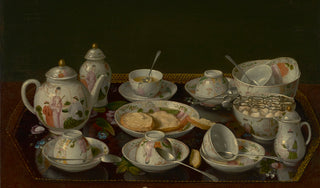In my journey with Maison Fête, I've developed a deep appreciation for the elegance of the past, particularly in the realm of glassware. This fascination led to the creation of our emerald green Annie Goblet, inspired by Georgian-style drinking glasses. It's not just a goblet; it's a revival of history, allowing you to experience a bygone era with each sip. We may not be able to travel back in time, but with the Annie Goblet in hand, I feel transported to the grandeur of Georgian times. To further immerse you in that period, I've put together five intriguing drinking facts from the era, painting a picture of its lavish and sophisticated lifestyle.

Jan Steen - The Dissolute Household
1- Drinking Port as a Patriotic Duty
Port was the celebrated wine of choice, a heady concoction of robust red wine fortified with the warmth of brandy. Its popularity soared, fuelled not just by its rich taste but also by political intrigue. Thanks to preferential tariffs favouring Portuguese products over those from Bourbon France, savouring a glass of port became more than a mere indulgence; it turned into a patriotic act for the free-born Englishman. This surge in port's popularity naturally sparked a heightened demand for elegant decanters and stylish coasters, turning them into symbols of taste and national pride.

2- Engraving and Etching
During the Georgian era, the art of glassware reached new heights with the enhancement of decorative techniques such as engraving and etching. Glass artisans of the time meticulously created intricate designs on their pieces, showcasing elegant motifs of flowers, birds, and classical scenes that reflected the era's artistic preferences. This period was marked by a deep appreciation for detail and craftsmanship, with each piece of glassware not just serving a functional purpose but also standing as a testament to the artistic skills of its creator. This blossoming of glass artistry not only made Georgian glassware highly prized in its time but also turned these pieces into cherished antiques, sought after for their historical and artistic value.

Champagne Glass 1750-1760 V&A Museum
3- Claret & Champagne Drinking for the Rich
Claret, with its origins in the French ‘clairet,’ a sumptuous dark rosé hailing from Bordeaux, became a symbol of refined taste in England between the 12th and 15th centuries. Its name was anglicised to ‘claret,’ reflecting its widespread popularity among the English elite. Sipping on claret was more than a mere choice of beverage; it was a statement of class and distinction, setting the affluent apart from the more common port drinkers. This rich, historical drink carried with it an air of sophistication and exclusivity, marking its consumers as part of an elite circle.
Champagne's introduction in the 18th century marked a significant moment, brought to England by gentlemen returning from their Grand Tours on the Continent. This sparkling discovery quickly became a symbol of sophistication and exclusivity, cherished by the elite. Its consumption was more than enjoyment; it was a statement of elegance and societal status. Champagne, rich in history, not only delighted the palate but also signified one's distinguished position in high society, making it a prized emblem of luxury and refinement.

Johann Zoffany - William Berry Introduced as heir to Raith
4- Evolution of glassware
Up until the 15th century, glass production primarily focused on architectural needs, beautifying households and churches. It wasn't until the 1570s that quality glassware for everyday domestic use began to emerge, marking a significant shift in the glassmaking industry. Between 1710-1750, glassware was characterised by its plain, heavy design. However, in 1745, a pivotal change occurred with the introduction of a glass tax by weight by the British government. This led to the ingenious development of the air twist stem, a revolutionary technique that made glasses lighter and more affordable. This innovation not only transformed glassware design but also made it more accessible, shaping the way we appreciate and use glass in our daily lives.
5- Toasting glasses
The 18th century witnessed the creation of some of the finest Georgian drinking glasses, particularly renowned for their use in toasting, a practice rich in tradition and elegance. These exquisite glasses are not just artefacts; they are a vivid testament to the era's craftsmanship and social customs. A glimpse into their historical significance can be seen in the Royal Collection's painting "A Dinner Party c.1719-25" by Marcellus Laroon the Younger. This artwork beautifully captures a moment in time, depicting two young guests engaged in the intimate act of toasting. The detail in the painting highlights the intricate design and refined beauty of this act, offering a window into the sophisticated world of 18th-century social gatherings.

Indulge in a White Port and Tonic Cocktail: A Georgian-Inspired Elegance in Your Annie Goblet
Here at Maison Fête, we have a soft spot for tradition, and we absolutely adore how our Annie Goblets enhance the experience of sipping a classic red or white wine. But don't let tradition limit your imagination! Try this simple yet elegant cocktail recipe this weekend, perfectly crafted to showcase your Annie Goblet. Elevate your gathering and bring a touch of elegance to your table with these revival Georgian goblets.
White Port and Tonic
Ingredients:
⅓ parts dry white port
⅔ parts tonic water
1 lime
Mint to garnish
Method:
Pour the dry port into the Annie Goblet with 2 ice cubes. Add the tonic water and stir. Garnish with mint leaves and lime zest.




